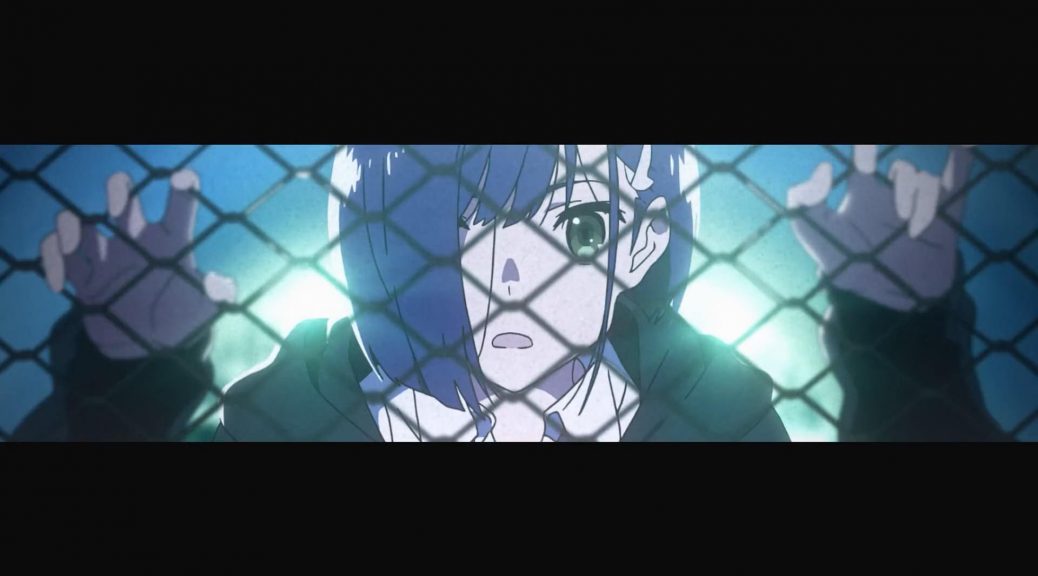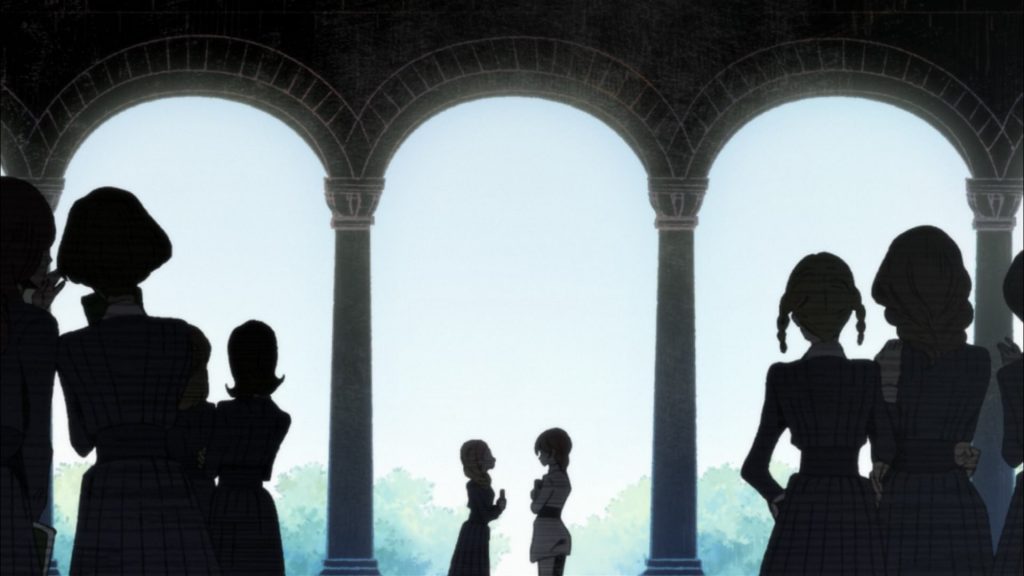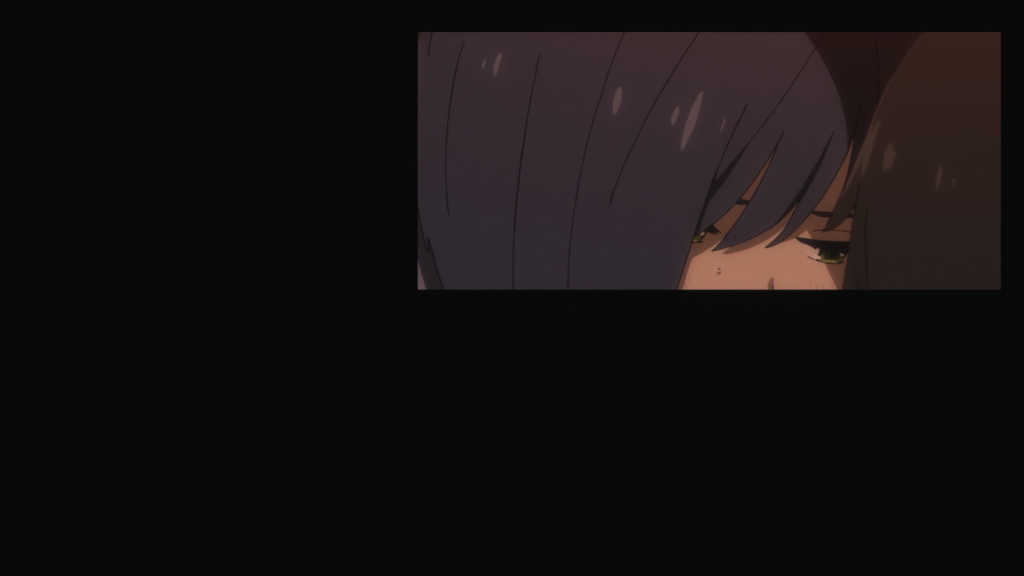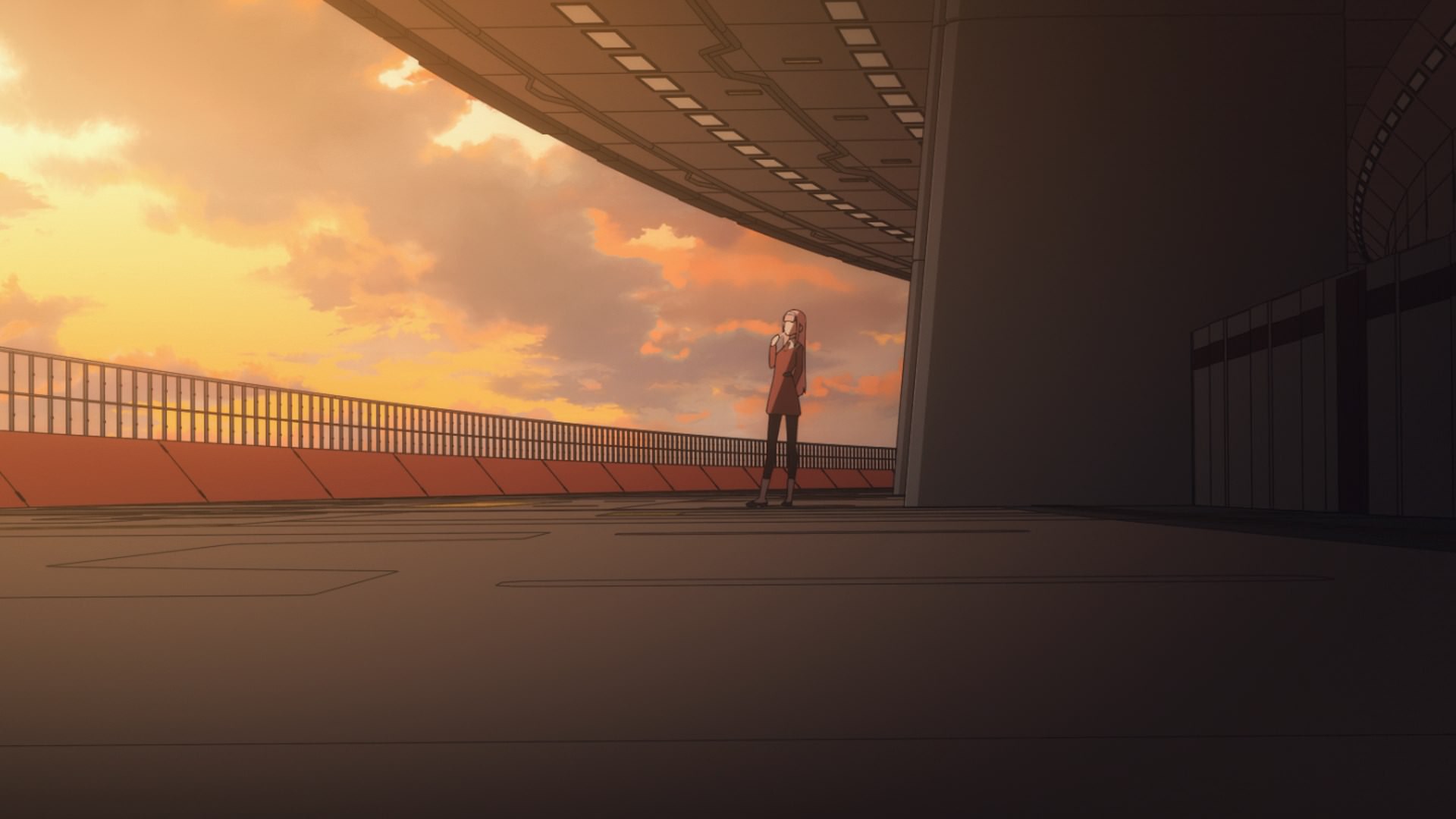
DARLING in the FRANXX – Episode 2
The second episode of DARLING in the FRANXX is also very much rooted in studio Gainax tradition, but its awkward budding sexuality and mecha happenings have a different flavor under the expert hand of one of the most interesting female creators who matured at the studio in the 00s: Shouko Nakamura. Get ready to catch up on the ways she polished up those unique skills, since that provides lots of hidden context to this episode.
Episode 2
StoryboardStoryboard (絵コンテ, ekonte): The blueprints of animation. A series of usually simple drawings serving as anime's visual script, drawn on special sheets with fields for the animation cut number, notes for the staff and the matching lines of dialogue., Episode DirectionEpisode Direction (演出, enshutsu): A creative but also coordinative task, as it entails supervising the many departments and artists involved in the production of an episode – approving animation layouts alongside the Animation Director, overseeing the work of the photography team, the art department, CG staff... The role also exists in movies, refering to the individuals similarly in charge of segments of the film.: Shouko Nakamura
Chief Animation DirectionAnimation Direction (作画監督, sakuga kantoku): The artists supervising the quality and consistency of the animation itself. They might correct cuts that deviate from the designs too much if they see it fit, but their job is mostly to ensure the motion is up to par while not looking too rough. Plenty of specialized Animation Direction roles exist – mecha, effects, creatures, all focused in one particular recurring element.: Masayoshi Tanaka
Animation DirectionAnimation Direction (作画監督, sakuga kantoku): The artists supervising the quality and consistency of the animation itself. They might correct cuts that deviate from the designs too much if they see it fit, but their job is mostly to ensure the motion is up to par while not looking too rough. Plenty of specialized Animation Direction roles exist – mecha, effects, creatures, all focused in one particular recurring element.: Masaru Baba, Mitsuko Baba, Naoto Nakamura
Mechanical Animation DirectionAnimation Direction (作画監督, sakuga kantoku): The artists supervising the quality and consistency of the animation itself. They might correct cuts that deviate from the designs too much if they see it fit, but their job is mostly to ensure the motion is up to par while not looking too rough. Plenty of specialized Animation Direction roles exist – mecha, effects, creatures, all focused in one particular recurring element.: Kazuyuki Asaka, Shota Iwasaki
Key AnimationKey Animation (原画, genga): These artists draw the pivotal moments within the animation, basically defining the motion without actually completing the cut. The anime industry is known for allowing these individual artists lots of room to express their own style.: Tomoyo Kamoi, Satoshi Yamaguchi, Noe Fukano, Yumi Kobayashi, Moeka Kuga, Taishi Kawakami, Shiori Tanaka, Minami Seki, Aiko Komamoto, Yuko Tagawa, Manami Umeshita, Naoya Takahashi, Masayuki Sato, Ai Takashi, Isao Hayashi, Kazuyuki Asaka, Mitsuko Baba
Emiko Shimura
Animation Production: A-1 Pictures Koenji
Ryan: If you missed our first post on the series, beware that our approach to discussing this series is for now based on gaining better understanding of the creators behind it to better interpret their vision for this series. Not that we’re against analyzing the show itself, but it feels very early to draw precise readings for a two cours series, and we’d rather not put our feet in our mouths – or our butts, considering what the show is about. This episode offers us a good chance to pick up where we left of last week and talk about yet another former Gainax member who’s made their way onto the show, albeit one who’s something of an outlier when compared to her peers. I hogged up the majority of last week’s post and left poor Kevin with little to talk about though, so it’s only fair that I let him say his piece now before I kick him off next week’s.
Kevin: Talking about this episode inevitably means tackling its central figure: Shouko Nakamura, its storyboarder and episode director. She made a name for herself with her work at Production I.G and Gainax, but it’s at the latter in particular where she developed her distinct artistic self and polished up her skills as an animator to begin with. Alongside her good friend Akemi Hayashi she represented the womanly side of 00s Gainax – always creating art with a striking sense of fashion, relying on very feminine and sexually charged imagery, capable of delicacy but also perfectly compatible with the puerile work some of her coworkers specialized in. A refined style that wasn’t at odds with her penchant for cartoony nonsense allowed her to quickly stand out as the leader of this faction of sorts at the studio.
Of course, it’s not just fans that she enamored, so she quickly grew a list of important acquaintances within the industry. Among the people who were attracted to her talent I would highlight the Yoshihiko Umakoshi crew and Terumi Nishii in particular; she’s been regularly working for them ever since she was part of the animation rotation on the original Mushishi, and that relationship has its effect on everything she works on nowadays still, as seen by the presence of animators like Mitsuko Baba in this episode. Over time and after Gurren Lagann in particular, her Gainax focus gradually faded, increasing her presence at Production I.G but also allowing her more chances to work with all these creators who wanted to collaborate with her. And once the massive studio exodus began, she abandoned the empty husk to tread her own path. Mind you, projects like this prove that these old bonds remain alive to this day, but it’s worth noting that she didn’t follow the larger groups who left Gainax at the time, instead doing her own thing.
Her career after that point is densely packed with interesting pieces that showcase her range – from her contributions to Kimi ni Todoke like its opening, that presents her femininity at its most innocent and makes good use of her stylish sense, to her irreverent final return home for Panty & Stocking with Garterbelt #2B, which exploits that same fashionable touch to capture the glamour of decadent celebrities and let her have fun with juvenile explicit sexuality. If there’s one title that changed her however, it’s got to be Penguindrum. While DARLING in the FRANXX‘s director Atsushi Nishigori was fulfilling his dream of directing The iDOLM@STER in summer 2011, on that same season Nakamura was acting as chief director alongside the one and only Kunihiko Ikuhara. She contributed design work, storyboards, animation, direction, and right about everything throughout the whole series, so it’s no surprise that she absorbed elements of his unmistakable aesthetic and added new resources in her ongoing quest to tackle sexuality. All of that was quickly put to use on episode 6 of Sayo Yamamoto’s Fujiko Mine: an incredibly Osamu Dezaki setup within an all-girls school was the perfect canvas to test those influences that shared the same DNA, which allowed her to toy with tropes like the flower garden and craft a very sexual, literal prison of love, as the episode is titled. Nakamura never silenced her own voice, but over the years it’s become obvious how meeting other idiosyncratic creators has little by little added more texture and layers to it. The core is the same, yet there is so much more to it now.
If we move to recent times, and I swear this will finally lead us to the episode we’re supposed to tackle, we find her magnum opus to this day: Doukyuusei. A delightful boys love film that fit her sensibilities like a glove, allowing her a more tender approach but still both whimsical and very sexually charged, which finally married her Gainax beginnings with everything she’d gained after that. The film itself is one of the most interesting expressions of the legendary studio’s quest to capture the passion of adolescence, again feeling very cohesive with her overarching vision. Many of her quirks were amplified during the production of the movie and have remained ever since. This episode of DARLING in the FRANXX opens up with paneling to isolate characters and their feelings, a technique she used over and over in the film. She’s far from the only anime director who’s fond of this trick, as this same season’s Hakumei and Mikochi can attest, but I find her usage much more interesting than Masaomi Ando’s; rather than a seemingly arbitrary gimmick, it comes off as a nuanced gesture to highlight contrast, capture the most evocative details, and every now and then to summarize actions and accelerate the pacing a little bit. The episode is filled not just with that, but also other elements that transparently show Nakamura’s hand – the blatantly Evangelion shots that explain her origins, a palpable Ikuhara feel from the architecture as she’s the one who designed their institution, the exaggerated profile shots that she’s always been fond of, even the exuberance of goofy faces in general as an outlet for her cartoony tendencies. Tonally this episode might feel very different from the material she’s been putting out lately, but at the same time, a quirky, awkward frustrated sexual experience is as Shouko Nakamura as it gets.
Ryan: Now that’s quite the introductory essay, but there was no avoiding that considering how deeply tied this episode is to Nakamura’s career. With that out of the way though, it’s time we actually delve into the episode itself. As Kevin pointed out, it’s very much about sex. There was little to no attempt to hide it. The overt moments stand out most for obvious reasons, but I believe that the understated ones serve as much more brutal presentations of the situation at hand, particularly during the events following Hiro and Ichigo’s kiss. Not only is the latter’s failure to stir a reaction in the former put on display to those overseeing the mock battle, Ichigo lowering her head in frustration is what leads to us learning that Zero Two happens to be one of them. And she’s less then impressed by everything going on. Nakamura’s eye for contrast is used in a ruthless way here! Zero Two’s advantage had already been made clear through her knowledge of terms and concepts the Parasites hadn’t so much as heard of, but this time it’s driven home all at Ichigo’s expense. Because the curse of the Masayoshi Tanaka cute blue girl continues to haunt me even after Waiting in the Summer.
Another theme from our introduction post was character expression as the main focus of the production, which we can once again experience this week. The cartoony faces are likely what stood out for most viewers in that area, which is entirely understandable. A byproduct of Nakamura’s fondness for that sort of fun nonsense that helps humanise the Parasites to an extent despite their glaring immaturity, alongside seemingly trivial shots of how the boys lay out their socks and shoes, giving us a peek at their personalities and habits. There’s plenty of little moments scattered all about the episode that let us know more about them, my favourite being the playful interaction between Ichigo and Goro following their encounter with Zero Two, as well as Ichigo covering her cheek when approached by Zero Two once again based on her experience on their previous encounter. Moments like everyone getting ready for their first test run and the lead up to and break up of the fight between Hiro and the ugly garbage gremlin Zorome that allow the key animationKey Animation (原画, genga): These artists draw the pivotal moments within the animation, basically defining the motion without actually completing the cut. The anime industry is known for allowing these individual artists lots of room to express their own style. team to prove how wonderful a job they can do in adhering to both the focus itself and Nakamura’s take on it, but the shining star this time around is without a doubt Isao Hayashi. While I’ll skip the history lesson on him for the time being since we’ve already exceeded our quota for the week, I do feel it important to highlight that his particular skillset makes him one of the most compatible animators with this project. He was tasked with the events following Hiro and Ichigo’s kiss that I touched upon previously, ideal in that it allowed him to weave both his unique brand of character acting and action sense into one impressive sequence, even with the latter portion only serving as a snippet of the overall picture. His skill is matched only by his work pace — he’s slated to make an appearance three episodes in a row as well as on the OP — so anyone looking forward to seeing more of him are bound to be pleased.
This is honestly a line I never thought I would have to type, but the philosophy of character expression is tied directly to the titular mechs as well. The pre-broadcast special gave us access to some behind the scenes from the production, where mechanical designer Shigeto Koyama discussed how he found director Nishigori Atsushi somewhat difficult to work with as he wasn’t sure what sort of robot designs would suit his tastes. He eventually reached the conclusion that he should design them as if they were girls, based on Hiroyuki Imaishi’s suggestion that Nishigori would appreciate unusual designs, but went the extra mile and designed them with the imas girls in mind. The shape and body of each FRANXX were only part of the focus, though; Nishigori himself took a hands on role when it came to their very human expressions, and there were plenty of talks between the two as to how they should move as well. We’ve yet to see too much of each FRANXX in action, but the glimpses we’ve gotten so far make it apparent that not only are their designs based on the pistils who pilot them, their movements are intended to make each unit feel like an extension of each girl and their personalities even if the boys are technically the main pilots. Perhaps something that may work into the story itself later down the line, but who knows for now!
Kevin: The way the mech designs came to be is an interesting detail, but maybe Koyama should be more honest with himself and accept that he just wanted to slap some boobs onto his own Tauburn design. But I digress, so let’s return to the production talk. The project is lucky to have the support of not just glamorous names like all the ones we’ve been mentioning and the sakugaSakuga (作画): Technically drawing pictures but more specifically animation. Western fans have long since appropriated the word to refer to instances of particularly good animation, in the same way that a subset of Japanese fans do. Pretty integral to our sites' brand. fleet approaching next episode, but also a multitude of less flashy but still very interesting animators. A quick glance reveals many such cases this week: the very last Gainax star Moeka Kuga, Kyoto Animation-bred Tomoyo Kamoi whom you might know for the original Kyoukai no Kanata designs, ex-Ghibli and Khara regular Yuko Tagawa, the current member of the imas crew Naoya Takahashi who polished up her skills at ufotable, charming character designer Masayuki Sato, even youngsters with theatrical education like Ai Takahashi. A very complete team that supports the production even when it’s not going all out. This time around they were also complimented by many Doukyuusei staffers, something animation producer Fukushima mentioned was an intentional move. The management staff promised they did their best to assemble this crew, and it seems like they weren’t exaggerating.
As a final note, and leaving craft matters aside for a moment, I have to say that I ended up enjoying this second episode much more than the first one. Nakamura’s style resonates with me even more than Nishigori’s also lovely approach, and I really do believe that this awkward horny mess is very much up her alley – which is good, because she’ll definitely be a regular contributor to this show. I still have no idea where it’s headed, besides the increasingly more obvious subversion regarding Hiro and Zero Two’s piloting, but for now I’m still fascinated by this series on a production level, while finding it fun enough to watch. In the end I might be just as juvenile as the show, because I’m still mildly amused by all the double entendres and the fact that a very seriously framed mecha fight was all about erectile dysfunction.
Ryan: I’ve yet to find myself coming around to the show, and if anything this episode did less for me than the premier on a purely personal front. I do believe a moment will come where Nishigori finally catches me once and for all, but much like I said last week, the people assembled for this project will ensure that I stick around no matter what. Especially with monster episodes like the one coming up!
Opening
StoryboardStoryboard (絵コンテ, ekonte): The blueprints of animation. A series of usually simple drawings serving as anime's visual script, drawn on special sheets with fields for the animation cut number, notes for the staff and the matching lines of dialogue.: Atsushi Nishigori
Direction: Toshifumi Akai
Animation DirectionAnimation Direction (作画監督, sakuga kantoku): The artists supervising the quality and consistency of the animation itself. They might correct cuts that deviate from the designs too much if they see it fit, but their job is mostly to ensure the motion is up to par while not looking too rough. Plenty of specialized Animation Direction roles exist – mecha, effects, creatures, all focused in one particular recurring element.: Masayoshi Tanaka
Mechanical Animation DirectionAnimation Direction (作画監督, sakuga kantoku): The artists supervising the quality and consistency of the animation itself. They might correct cuts that deviate from the designs too much if they see it fit, but their job is mostly to ensure the motion is up to par while not looking too rough. Plenty of specialized Animation Direction roles exist – mecha, effects, creatures, all focused in one particular recurring element.: Shota Iwasaki
Key AnimationKey Animation (原画, genga): These artists draw the pivotal moments within the animation, basically defining the motion without actually completing the cut. The anime industry is known for allowing these individual artists lots of room to express their own style.: Tomoaki Takase, Naoya Takahashi, Toshifumi Akai, Kazuyuki Asaka, Shingo Abe, Isao Hayashi, Terumi Nishii, Kouta Michishita, Sejoon Kim, Taishi Kawakami, Masayoshi Tanaka, Megumi Kouno, Kazutaka Sugiyama
Ryan: I’d be lying if I said I was a fan of this one, but at the same time it feels like quite the task to construct a fitting sequence around the song they’ve chosen for it. One part I do like is the end, which just so happens to be Kouno’s work. Particularly the longing of Zero Two’s expression as she mimics the ‘darling’ portion of the lyrics.
Kevin: The motion graphics and design work of the opening are pretty neat, so it wasn’t surprising to see Koji Aramaki’s name tied to that aspect – a good chance for me to plug The Perfect Insider’s opening again. Kouno’s animation and Sejoon Kim’s delightful mecha timing are my favorite bits, though I wish the latter had more of a chance to draw his water splash-like FXFX: Shorthand for effects animation – water, fire, beams, that kind of cut. A pillar of Japanese 2D animation.. Otherwise, not exactly a big fan of this sequence, which feels like Kiznaiver’s approach gone wrong.
Ending
StoryboardStoryboard (絵コンテ, ekonte): The blueprints of animation. A series of usually simple drawings serving as anime's visual script, drawn on special sheets with fields for the animation cut number, notes for the staff and the matching lines of dialogue.: Rika Tanabe
Direction, Animation DirectionAnimation Direction (作画監督, sakuga kantoku): The artists supervising the quality and consistency of the animation itself. They might correct cuts that deviate from the designs too much if they see it fit, but their job is mostly to ensure the motion is up to par while not looking too rough. Plenty of specialized Animation Direction roles exist – mecha, effects, creatures, all focused in one particular recurring element., Key AnimationKey Animation (原画, genga): These artists draw the pivotal moments within the animation, basically defining the motion without actually completing the cut. The anime industry is known for allowing these individual artists lots of room to express their own style.: Yoneyama Mai
2nd Key AnimationKey Animation (原画, genga): These artists draw the pivotal moments within the animation, basically defining the motion without actually completing the cut. The anime industry is known for allowing these individual artists lots of room to express their own style. Printed by: Totos
Kevin: I started this post talking about Shouko Nakamura as the main figure of the women of Gainax circa mid 00s, but Mai Yoneyama’s ending sequence is a good reminder that the very late stages of the studio featured another group who shared very similar sensibilities. Yoneyama was part of the Chuo-sen Anime Sisters circle alongside Hiromi Taniguchi, Kana Shundo, and Natsuki Yokoyama. As you can see on their publications, they were also all about trendy fashion with a spice of sexiness sometimes. The sensuality is held back for once, but that stylish sense is all over the ending sequence. The aesthetic feels modern, but as stellar animator Ryo Imamura noted, some of the layoutsLayouts (レイアウト): The drawings where animation is actually born; they expand the usually simple visual ideas from the storyboard into the actual skeleton of animation, detailing both the work of the key animator and the background artists. have quite the old-school flavor to them too. This ending is simply excellent, and its debut on an episode helmed by Shouko Nakamura feels absolutely perfect. Now if an A-1 insider was so kind as to reveal who’s hiding behind the storyboarder’s mysterious pen-name…
Ryan: A strong contender for ED of the year, as far as I’m concerned! If there’s something I’d like to highlight that Kevin hadn’t already, it’d be the clever use of colour shades and loss of outlines on Zero Two’s hair. Also Ichigo is cute…
Support us on Patreon to help us reach our new goal to sustain the animation archive at Sakugabooru, SakugaSakuga (作画): Technically drawing pictures but more specifically animation. Western fans have long since appropriated the word to refer to instances of particularly good animation, in the same way that a subset of Japanese fans do. Pretty integral to our sites' brand. Video on Youtube, as well as this SakugaSakuga (作画): Technically drawing pictures but more specifically animation. Western fans have long since appropriated the word to refer to instances of particularly good animation, in the same way that a subset of Japanese fans do. Pretty integral to our sites' brand. Blog. Thanks to everyone who’s helped out so far!





Gosh, this was an amazing read! Getting a better handle on Nakamura’s approach really helped me appreciate the episode so much more. I liked that this was like almost half just a highlight of her as a creator.
Also, the ED is so fantastic. And Ichigo IS cute.
My “please watch Doukyuusei” propaganda was disguised as a post and it sort of worked.
Oh, as soon as I saw Honda’s work on Doukyuusei I knew I had to watch it. lol
“beware that for now our approach to discussing this series is for now based on”
Inadvertent tautology there.
Oooops, fixed.
This might be the Nakamura backstory episode we need but I LOL’d how half the images embedded in the post are not related to Darifra, even.
It’s basically Shouko Nakamura Spotlight and also Darlifra: the post, so it works! Yeah!